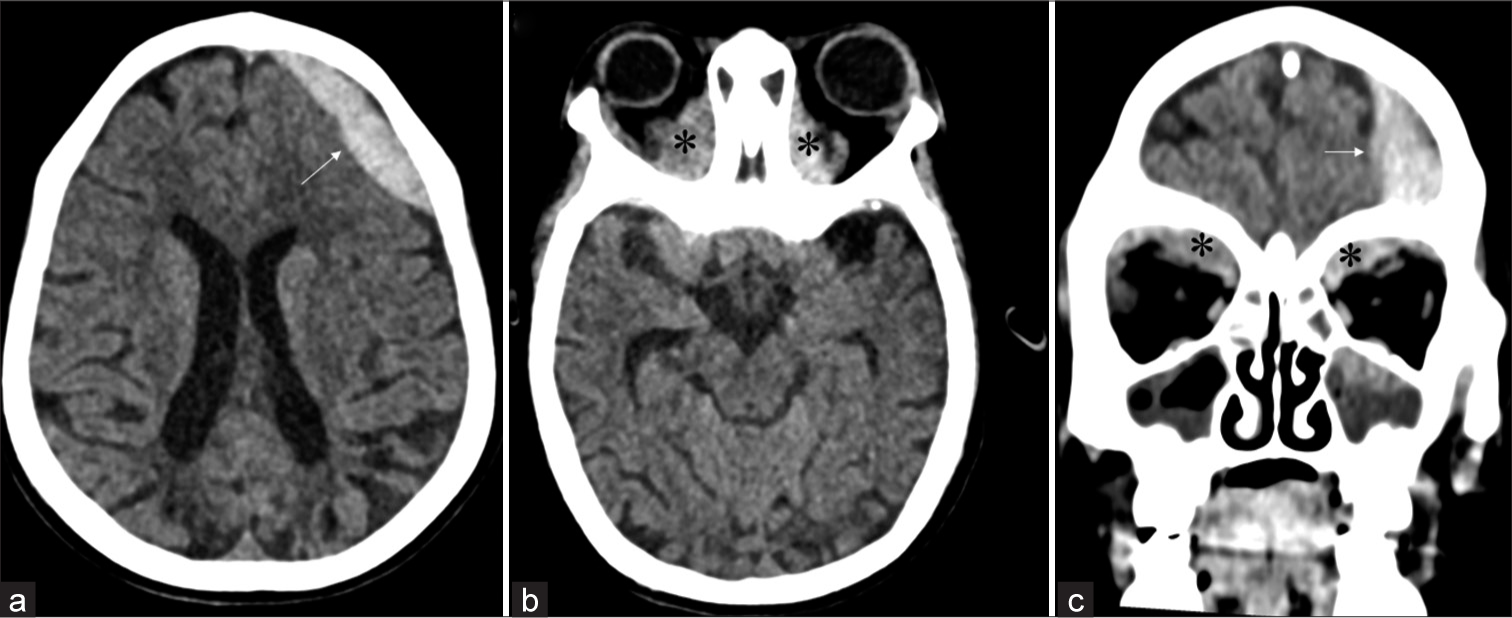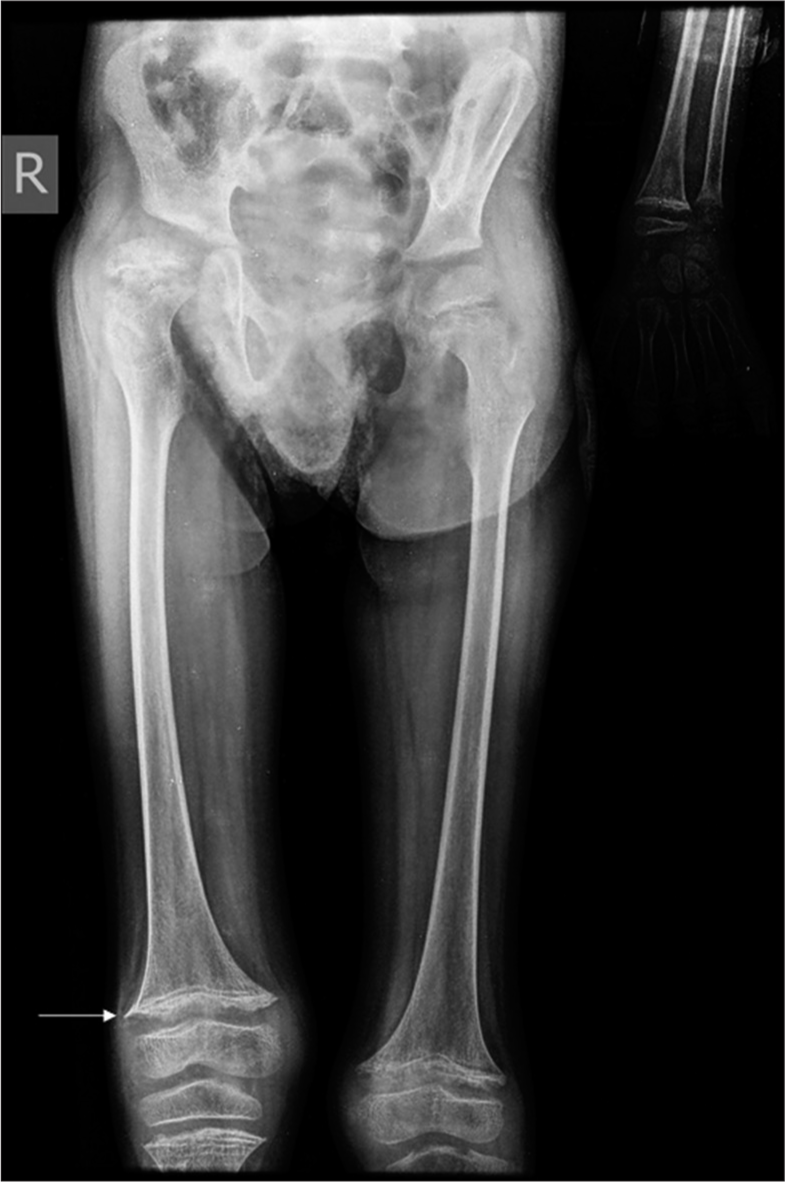Translate this page into:
Spotting the scurvy’s sight: Spontaneous intraorbital hematomas causing bilateral acute proptosis
*Corresponding author: Zubin Vicky Driver, Department of Radiology, Seth GS Medical College, KEM Hospital, Mumbai, Maharashtra, India. driverzubin9@gmail.com
-
Received: ,
Accepted: ,
How to cite this article: Gala F, Driver ZV. Spotting the scurvy’s sight: Spontaneous intraorbital hematomas causing bilateral acute proptosis. Wadia J Women Child Health. 2024;3:87-9. doi: 10.25259/WJWCH_33_2024
Abstract
Spontaneous intraorbital hematomas in a child with no history of malignancy, coagulopathy, or child abuse can have nutritional deficiency leading to increased risk of bleeding. Children with neurological impairment are more prone to develop scurvy. Scurvy in a child presents with both musculoskeletal findings and bleeding diathesis and, therefore, a radiologist should be well-versed with the classical osseous changes on radiographs and with unusual, yet important radiological clues of intraorbital and intracranial hematomas on computed tomography.
Keywords
Scurvy
Intraorbital hematoma
Intracranial hematoma
Computed tomography
Vitamin C
INTRODUCTION
Scurvy is a preventable and easily treatable disease; however, due to nonspecific clinical features, the diagnosis is not well-established unless the imaging or biochemical assays are done. Here, we present the case of a 9-year-old boy with acute onset bilateral proptosis who was diagnosed with scurvy based on the radiological imaging.
CASE REPORT
A 9-year-old boy, who had cerebral palsy, presented with the complaints of acute onset bilateral proptosis of 12 hours duration. On examination, the child was irritable, had bleeding gums, and poor dentition in the form of loose teeth and multiple caries. The child was under-weight (weight – 12.5 kg, body mass index z-score −2 to –3 standard deviation suggestive of thinness). For the above complaints, computed tomography (CT) brain was requested. On CT brain [Figure 1a], there was an extra-axial biconvex shaped hyperdense lesion of blood attenuation and of 12 mm thickness along the left frontal region suggestive of extradural hematoma. Two well-defined hyperdense lesions of blood attenuation [Figure 1b and c] measuring 2 × 1.5 × 1 cm on either side were also noted in bilateral superior subperiosteal, intraorbital, and extraconal fat spaces. Bilateral extraocular muscles were normal. No calvarial or orbital bone fracture was seen. Routine blood investigations revealed hemoglobin to be 9 g/dL. The liver function test and coagulation profile parameters were within normal limits and the child was then suspected of nutritional deficiency. A bilateral thigh radiograph was performed which showed [Figure 2] osteopenia predominantly in the lower half with cortical thinning and few metaphyseal spurs in both the femurs. Child was diagnosed with scurvy based on radiological findings and started on Vitamin C supplementation. The pretreatment Vitamin C levels sent after the imaging were 0.25 mg/dL, which was low. Post-treatment, there was complete resolution of bilateral proptosis.

- Non-contrast computed tomography (CT) brain in (a) axial plane shows a well-defined extra-axial biconvex shaped lesion (white arrow) of blood attenuation of 12 mm thickness along the left frontal region suggestive of extradural hematoma. Non-contrast CT brain in (b) axial and (c) coronal planes show an extradural hematoma in the left frontal region (white arrow) and two well-defined hyperdense lesions (black asterisks) of blood attenuation measuring 2 × 1.5 × 1 cm on either side in bilateral superior subperiosteal, intraorbital and extraconal fat spaces suggestive of intraorbital hematomas. Bilateral extraocular muscles are normal. No calvarial or orbital bone fracture is seen.

- Bilateral thigh radiograph shows osteopenia predominantly in the lower half with cortical thinning and few metaphyseal spurs (white arrow) in both the femurs.
DISCUSSION
Vitamin C as a micronutrient and antioxidant plays a key role in the synthesis of collagen, chondroid, and osseous tissue, all of which are derivatives of mesenchymal stem cells. It improves iron absorption in the gastrointestinal tract and is also involved in the coagulation pathway synthesis.[1] Deficiency of Vitamin C leads to poor development of vessels, skin, cartilages, and bones and, thus, manifest with classical bony abnormalities and bleeding diathesis. In humans, Vitamin C is not produced endogenously due to lack of L-gluconolactone oxidase, and thus, it is one of the essential vitamins that is present in citrus fruits.[2] Children who primarily consume pasteurized milk or on antiepileptic drugs are at higher risk of Vitamin C deficiency.[2] Due to deficiency, there is defective collagen synthesis of skin and blood vessels leading to easy bruising. Defective collagen synthesis also leads to osteopenic changes in the bones.
Nearly, 80% of the pediatric scurvy cases present with pain, swelling, and limping in the extremities.[3,4] Other clinical features include bleeding gums, anemia, perifollicular hemorrhage, pseudo-paralysis, and delayed wound healing. Proptosis secondary to orbital hematoma, subarachnoid hemorrhage, subdural hemorrhage, hematuria, alveolar hemorrhage, and hemorrhagic pleural effusion are rare manifestations of scurvy.[4-7]
An orbital or intracranial hematoma is seen more commonly in patients with head and neck trauma, which is usually unilateral, seen at the site of impact, and has associated skull or facial bone fracture. In a case of bilaterally symmetrical intraorbital hematomas, non-traumatic causes such as metastasis from small round cell tumor, leukemic deposits, vascular malformation, or bleeding diathesis are initially considered.[6,8] When all these conditions are ruled out, and the child has clinical features pertaining to the musculoskeletal system, one should start thinking on the lines of nutritional deficiencies. Proptosis in scurvy is secondary to the rupture of fragile capillary walls in subperiosteal loose alveolar tissue of extraconal space. It is usually acute in onset and resolves in less than a month. Other ocular sites of bleeding in scurvy include subconjunctival tissue, eyelids, anterior chamber, and in the retina.[2]
On radiographs, scurvy presents with reduced bone density, cortical thinning, and mineralization in the provisional zone of calcification – Frankel’s line, adjacent reduced osteoblastic activity – Trummerfeld’s zone, bony projection in the metaphysis of long bones – Pelkan spur, central lucency with sclerotic margins in epiphysis – Wimberger’s ring, and swelling in the soft tissue with elevation of the periosteum secondary to subperiosteal bleed.[9]
The primary treatment for scurvy is to replenish Vitamin C with a daily dose of 100–200 mg over a period of 3 months; however, due to multivitamin deficiency status, concomitant Vitamin B and D supplementation is also given.[2]
A retrospective study done on 28 proven cases of scurvy for 7 years duration concluded that musculoskeletal manifestations were more common and these children were fed with pasteurized milk with lack of fruits and vegetables intake in the diet.[7] Although spontaneous bleeding due to scurvy is less common, few cases have been reported in the literature. Almost all the intraorbital hematoma cases that were reported had neurologic impairment with proptosis, showed osseous changes on radiographs, and improved dramatically on Vitamin C supplementations.[2,4,6] A combination of both intraorbital and intracranial hematoma was unique in our case and to our knowledge only one case has been reported till date.[10] Few cases reported only bleeding diathesis without any musculoskeletal changes.[1]
CONCLUSION
Near symmetrical orbital hematomas without fracture in a neurologically disabled child should arouse a suspicion of nutritional deficiency like scurvy which is a preventable disease. A differential diagnosis of suspected child abuse should also be kept in mind apart from scurvy in a child with normal coagulation profile and intracranial bleed. Radiographs are useful to diagnose the classical osseous changes while CT is useful for the orbital and intracranial hematomas in hypovitaminosis C.
Ethical approval
Institutional Review Board approval is not required.
Declaration of patient consent
The authors certify that they have obtained all appropriate patient consent.
Conflicts of interest
There are no conflicts of interest.
Use of artificial intelligence (AI)-assisted technology for manuscript preparation
The authors confirm that there was no use of artificial intelligence (AI)-assisted technology for assisting in the writing or editing of the manuscript and no images were manipulated using AI.
Financial support and sponsorship
Nil.
References
- An unusual presentation of scurvy following head injury. Indian J Med Sci. 2002;56:440-2.
- [Google Scholar]
- An unusual case of spontaneous bilateral orbital hematoma. Am J Clin Case Rep. 2021;2:1033.
- [Google Scholar]
- Infantile scurvy: A historical perspective. Pediatrics. 2001;108:e76.
- [CrossRef] [PubMed] [Google Scholar]
- Spontaneous orbital haematoma in a scurvy child: A forgotten diagnosis. Int J Pediatr Otorhinolaryngol. 2020;137:110224.
- [CrossRef] [PubMed] [Google Scholar]
- Hemorrhagic pleural effusion: Can it be scurvy? Indian J Pediatr. 2007;74:1050-1.
- [CrossRef] [PubMed] [Google Scholar]
- Bilateral proptosis: An unusual primary presentation of scurvy-a case report. Egypt J Radiol Nucl Med. 2021;52:1-5.
- [CrossRef] [Google Scholar]
- Scurvy in pediatric patients: A review of 28 cases. J Med Assoc Thailand. 2003;86:S734-40.
- [Google Scholar]
- Periorbital ecchymosis (raccoon eye) and orbital hematoma following endoscopic retrograde cholangiopancreatography. Case Rep Gastroenterol. 2017;11:134-41.
- [CrossRef] [PubMed] [Google Scholar]
- Scurvy: A rare case in an adult. Skelet Radiol. 2019;48:977-84.
- [CrossRef] [PubMed] [Google Scholar]
- Unilateral proptosis and extradural hematoma in a child with scurvy. Pediatr Radiol. 2007;37:937-9.
- [CrossRef] [PubMed] [Google Scholar]







